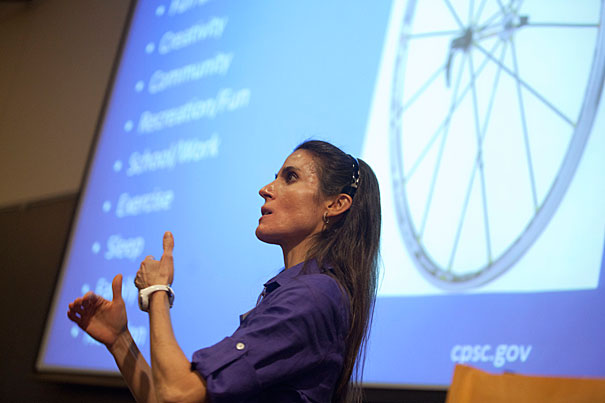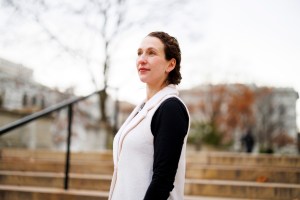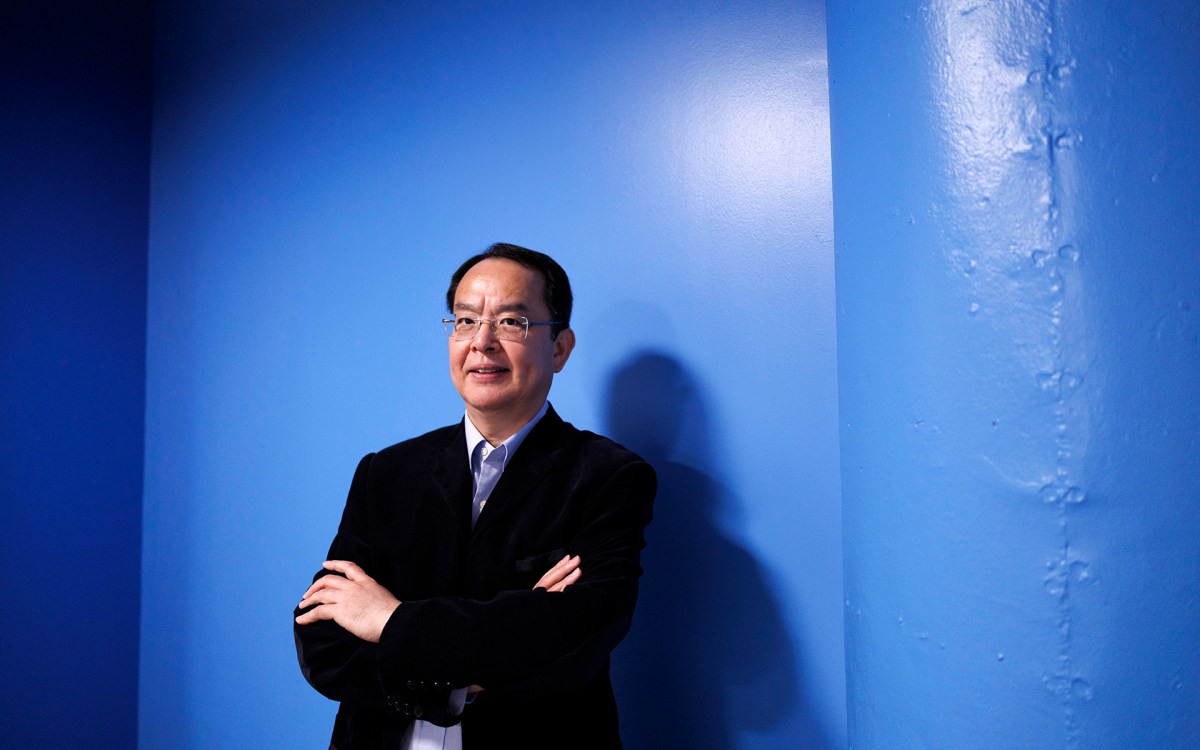
The Optimal Health program held over Wintersession brought Elizabeth Frates ’90, the director of medical student education at Boston’s Institute of Lifestyle Medicine, to the Fong Auditorium. Frates had students fill out a wellness wheel and rank on a scale of 1 to 10 the importance of friends, fun and recreation, sleep, nutrition, exercise, and other aspects of physical and mental health.
Kris Snibbe/Harvard Staff Photographer
A winter wellness workout
Program gives undergrads tools for fit, healthy living
Mandi Nyambi ’15 was excited to start college late last summer. She arrived at Harvard and immersed herself in academics, student life, and making new friends. Like many busy undergraduates, however, she soon found herself neglecting the basics of health and wellness.
“I got caught up in the new experience of college,” she said. “You forget about sleep and eating healthy because you think about the friends you make and the activities you can go to. Then you kind of get away from the routine that allows you to experience everything and still stay healthy.”
Nyambi and dozens of her classmates started 2012 with a new emphasis on wellness, thanks to the Optimal Health program held over Wintersession at the Fong Auditorium. Sponsored by the Center for Wellness and Harvard Athletics, Optimal Health touched on all the major aspects of prevention, with presentations from a lifestyle medicine consultant, a nutritionist, a sleep specialist, and other experts.
“We were very excited to have different professionals from around the University come and talk to students about optimal health,” said Jeanne Mahon, director of the Center for Wellness. “We tried to put together an afternoon of workshops that were both educational and fun.”
First up was Elizabeth Frates ’90, the energetic director of medical student education at Boston’s Institute of Lifestyle Medicine. Frates had students fill out a wellness wheel and rank on a scale of 1 to 10 the importance of friends, fun and recreation, sleep, nutrition, exercise, and other aspects of physical and mental health. Using the same scale, she had the students rate the amount of energy they were putting into each area. When they compared the two ratings, most in the crowd found that they weren’t putting a lot of time and effort into the aspects of wellness that were most important.
In response, Frates spoke to students about P.A.V.I.N.G. a path to wellness. “Physical activity [P] is a critical piece of wellness,” she said. “So is our attitude [A] and beliefs. It’s important to keep a variety [V] in all aspects of our life, whether physical activity or nutrition. You can’t keep working off old information about health, so constant investigation [I] is key. In the 1980s, for instance, fat was the enemy. Today, it’s sugar. Good nutrition [N] means a focus on fruits and vegetables, whole grains, healthy proteins, and fiber. And when you’re on a wellness journey, you have to continue to have concrete goals [G].”
To show students how easy it can be to integrate wellness into their lives, she had the group stand up and join her in jogging vigorously in place for two minutes. If many of the students were a little out of breath at the finish, they also felt invigorated and got the message that an expensive gym membership wasn’t a prerequisite for fitness.
“You can do things that don’t necessarily take you to the shower,” Frates said. “It’s great to work out and to take the hour, but you can also practice a little lifestyle medicine and get physical activity during the day.”
Next, Harvard University Health Services (HUHS) nutritionist Yeemay Su Miller gave students a primer on healthy eating. She listed the top three diseases in the United States — heart disease, cancer, and stroke — and said preventing each was heavily influenced by diet. The good news, she told the crowd, is that research shows it’s possible to change one’s sense of taste over time to prefer more healthy foods, such as whole grains, fruits and vegetables, and lean protein.
“We know fruits and vegetables are preventative for disease,” she said. The recommended 7 to 13 servings a day may seem like a lot, but it’s doable. If you don’t smoke and you get exercise, then good health really comes down to nutrition.”
Miller recommended that students eat smaller meals 4 to 5 times a day. Downsizing meal size prevents postprandial sluggishness, she said, and increased frequency ensures that the brain always has the glucose it needs for optimal function.
Her final advice was for students to be mindful when eating.
“Let eating be a pure pleasurable activity,” she said. “Engage all of your five senses. Don’t do work, watch TV, or surf the Web. Just eat.”
When Miller was done, Wellesley College’s Catherine Collins came in to help students get some sleep. She asked undergraduates how much rest they typically get each night. Most said that they slept only 4 to 6 hours, significantly less than the 7 to 9 hours necessary for optimal health.
“Sleep is something that is not extra,” Collins said. “It’s important for your academic health and well-being. What happens is that all you learn during the day gets synthesized when you go to sleep. Research shows that if you learn something new and want to be able to apply it, you really need to sleep.”
Collins gave students tips on getting good rest: Turn off the television or computer at least an hour before bed to give the body time to produce melatonin, the hormone that creates drowsiness; keep a “worry pad” by the bed for middle-of-the-night concerns about work; avoid alcohol, nicotine, and heavy exercise for 3 to 6 hours before bed. She also gave students advice on what to do when sleep won’t come.
“If you haven’t fallen asleep in 20 minutes, leave your bed. Read, doodle, crochet, or do something to take your mind off of what’s keeping you from falling asleep. If you don’t get 7 to 9 hours a night, a 20- to 30-minute nap can be restorative, and a 90-minute nap on the weekend can eat away at sleep debt.”
The afternoon’s program wrapped up with a quick tutorial on stress management from HUHS outreach nurse Lois Badwan, who gave students some simple advice on staying calm and happy.
“Find 15 to 30 minutes a day to shut off your cellphones, BlackBerries, etc.,” she said. “Eat well. Exercise daily. Talk to a friend. Above all, take time to laugh.”
Before moving into the lobby of Boylston Hall with her classmates to chat about wellness and to nosh on healthy snacks after the program, Jasmine Gipson ‘15 said she appreciated Optimal Health’s focus on active steps and practical information.
“They didn’t just spout a lot of facts,” she said. “They named resources on campus that could help — where the gyms were; what classes they offered; what the schedule is; what’s in the cafeteria; and what you should put on your plate. It was very specific to Harvard.”
Nyambi said Optimal Health will help her to resume many of the good habits she had when she arrived at Harvard.
“I was passionate about nutrition and living healthy in high school,” she said. “I wanted to continue at Harvard, but found in the fall that I had gotten away from wellness. This program was a good segue to changing things around and getting back to the way I was.”





